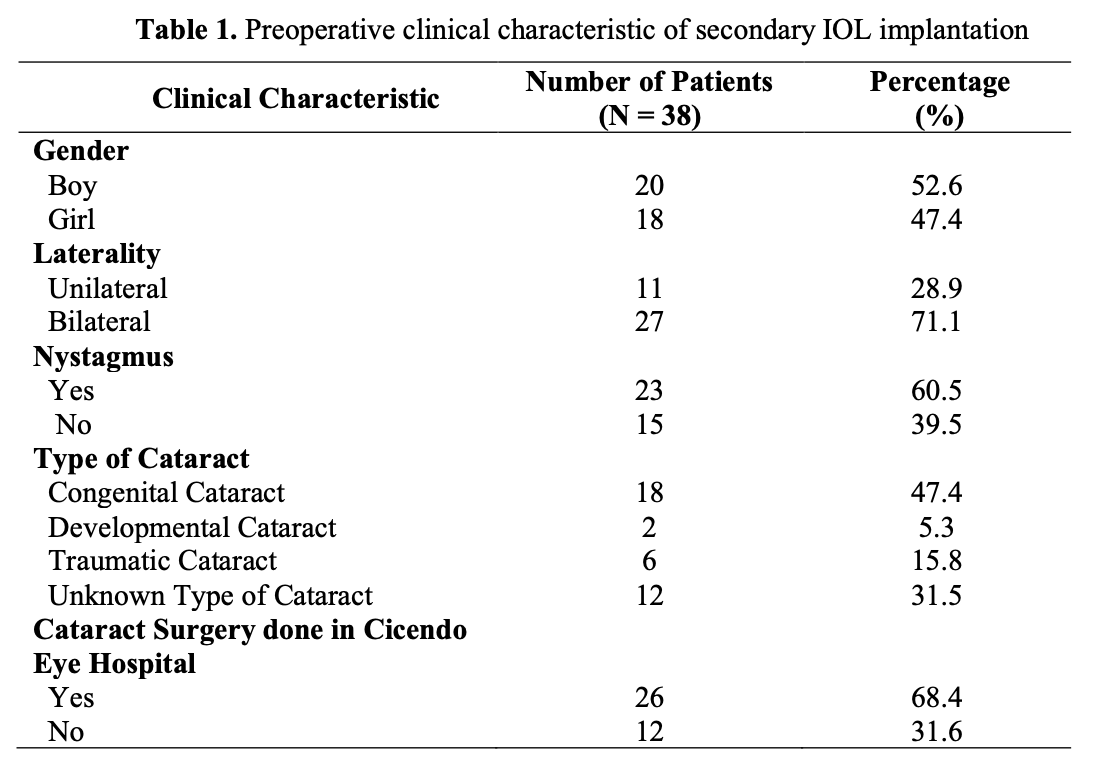A Case Report of Unilateral Pediatric Cataract Surgery: Posterior Capsule Opacification and Visual Rehabilitation
DOI:
https://doi.org/10.35749/journal.v47i2.100289Keywords:
posterior capsule opacification, deprivation amblyopia, pediatric cataractAbstract
Objective: To report a case of posterior capsule opacification (PCO) and severe deprivation amblyopia following unilateral pediatric cataract surgery
Case Presentation: A 4-year-old girl presented with PCO of the right eye with a history of unilateral congenital cataract surgery and intraocular lens (IOL) implantation without optimal visual rehabilitation two years ago at another hospital in Jakarta. Her uncorrected right eye visual acuity was 3/60 and corrected left eye visual acuity 6/7.5. We performed secondary posterior capsulotomy and anterior vitrectomy of the right eye. Following the procedure, the patient did not regain her vision despite normal posterior segment; thus, a diagnosis of deprivation amblyopia was made. She was prescribed occlusion therapy for 6 hours a day on the left eye to decrease the degree of amblyopia of her right eye.
Conclusion: Early identification and management of pediatric cataract surgery complications combined with optimal visual rehabilitation may benefit the patient in the long run. If not treated properly, especially in unilateral cataract cases, it may be too late to regain visual function.
Downloads
References
Vasavada AR, Praveen MR, Tassignon M-J, Shah SK, Vasavada VA, Vasavada VA, et al. Posterior capsule management in congenital cataract surgery. J Cataract Refract Surg. 2011;37(1):173–93.
Atkinson CS, Hiles DA. Treatment of secondary posterior capsular membranes with the Nd:YAG laser in a pediatric population. Am J Ophthalmol. 1994;118(4):496–501.
Lambert SR, Drack A V. Infantile cataracts. Surv Ophthalmol. 1996;40(6):427–58.
Kugelberg M, Zetterström C. Pediatric cataract surgery with or without anterior vitrectomy. J Cataract Refract Surg. 2002;28(10):1770–3.
Birch EE, Cheng C, Stager DRJ, Weakley DRJ, Stager DRS. The critical period for surgical treatment of dense congenital bilateral cataracts. J AAPOS Off Publ Am Assoc Pediatr Ophthalmol Strabismus. 2009;13(1):67–71.
Merino P, Gómez-de-Liaño P, Gil MR, Fernández AI, Yáñez J, Cortés C. Strabismus and congenital cataracts. Arch Soc Esp Oftalmol. 2007;82(10):623–8.
Vasavada AR, Nihalani BR. Pediatric cataract surgery. Curr Opin Ophthalmol. 2006;17(1):54–61.
Jensen AA, Basti S, Greenwald MJ, Mets MB. When may the posterior capsule be preserved in pediatric intraocular lens surgery? Ophthalmology. 2002;109(2):324—7; discussion 328.
Hosal BM, Biglan AW. Risk factors for secondary membrane formation after removal of pediatric cataract. J Cataract Refract Surg. 2002;28(2):302–9.
Sinha R, Shekhar H, Sharma N, Titiyal J, Vajpayee R. Posterior capsular opacification: A review. Indian J Ophthalmol. :371 OP-376 VO-61.
Peterseim MW, Wilson ME. Bilateral intraocular lens implantation in the pediatric population. Ophthalmology. 2000;107(7):1261–6.
Enyedi LB, Peterseim MW, Freedman SF, Buckley EG. Refractive changes after pediatric intraocular lens implantation. Am J Ophthalmol. 1998;126(6):772–81.
Plager DA, Kipfer H, Sprunger DT, Sondhi N, Neely DE. Refractive change in pediatric pseudophakia: 6-year follow-up. J Cataract Refract Surg. 2002;28(5):810–5.
Pehere NK, Chandrasekhar G, Kekunnaya R. The critical period for surgical treatment of dense congenital bilateral cataracts. J AAPOS. 2009;13(5):527—8.
Hosal BM, Biglan AW, Elhan AH. High levels of binocular function are achievable after removal of monocular cataracts in children before 8 years of age. Ophthalmology. 2000;107(9):1647–55.
Allen RJ, Speedwell L, Russell-Eggitt I. Long- term visual outcome after extraction of unilateral congenital cataracts. Eye (Lond). 2010;24(7):1263–7.
Wilson ME. Pediatric Cataracts: Overview. American Academy of Ophthalmology [Internet]. 2015. Available from: https://www.aao.org/disease- review/pediatric-cataracts-overview
Downloads
Published
Issue
Section
License

This work is licensed under a Creative Commons Attribution-NonCommercial-ShareAlike 4.0 International License.


